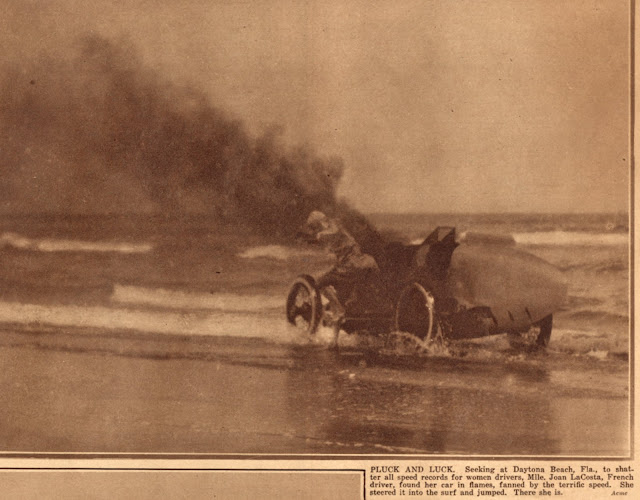November 7, 1929 — Joan LaCosta, prominent woman auto racer, was held by police in Chicago, Illinois for attempted robbery in a Chicago hotel, with chloroform and a toy pistol. When first arrested she refused to reveal her identity.
Joan LaCosta was a flamboyant French driver (apparently), mostly noted as a daredevil and speed triallist in the USA in the 1920s. Her usual car seems to have been a Miller special.
Joan’s origins are obscure. She appears in the mid-1920s, and by 1925, was proclaimed as the “women’s international champion”, as reported in the Santa Cruz Evening News. The Danville Bee, a Virginia newspaper, elaborated on this, claiming that she won her title in a women’s championship meeting at Indianapolis that year. No details of such a meeting are forthcoming, and Indianapolis was not a welcoming venue to women drivers. The event must have been held somewhere else. Reports from this time suggest that she was most active in Florida. Later, she would claim to have been racing on dirt tracks since about 1923, but this is proving hard to confirm.
There is more concrete evidence of one of the most dramatic incidents of her short career, from 1926. Whilst practicing for a speed record run on Daytona Beach in April, her car caught fire, traveling at about 130mph. The cause of the fire was a broken fuel line. A photographer was on hand to capture Joan leaping from the car, as she steered it into the sea in an attempt to douse the flames. She was not seriously hurt. Only a few days later, she made the record run in a different car, and set a series of new female records, driving at 138mph. The dramatic photos were reprinted in newspapers all across the United States.
 |
| Photo from the New York Herald Tribune of Sunday, May 2, 1926. |
Later in the year, she made another record run at Jacksonville beach, also in Florida. This time, she got up to 145mph, smashing her own record. The car was a Miller Special, although not much detail about it is available.
Her talents did not stop with record-breaking. In 1926, Joan entered a match race on a half-mile dirt track, as part of an IMCA (International Motor Competition Association) event in Toronto, Canada. IMCA was the only sanctioning body that allowed women to race at all. She won, beating Louis Disbrow. The two had considerable history, having raced against each other twice, in Canada and Mississippi. The same year as their Toronto battle, Disbrow apparently led a protest against Joan’s inclusion in a Lakewood starting grid. His objection was overturned, partly because her speed-trial times proved that she was faster than several of the male entrants.
IMCA’s leading promoter of the time was J. Alex Sloan, who believed in motor racing as spectacle, and used several woman drivers to add controversy and a touch of glamour to IMCA meetings. At the same time as he was promoting Joan, he was also using Elfrieda Mais, usually as a stunt performer, although she did race occasionally. The row with Disbrow must have had him rubbing his hands together with glee. Disbrow’s position on female drivers was also rather puzzling; his own career had been launched in the 1900s, as a riding mechanic to Joan Newton Cuneo, the first notable American female racer.
Her activities in 1927 are unclear. Her name does not appear on any published start lists for IMCA meetings, but she may well have continued to race at fairgrounds and horse-racing tracks.
In 1928, Joan won a women’s race in Milwaukee, but this was one of her last triumphs. At the end of the year, she announced her intention to retire and take up flying.
This did not happen, although she continued to appear in the news due to a conviction for robbery in 1929. She attempted to steal jewelry from another woman, using a replica gun in a hold-up situation. In defense, she claimed that she had lost “all of her money” at a horse race, and was unemployed. During her court appearance, she fainted and burst into tears of remorse.
By 1931, she had married a meat salesman called Joseph Maurer. At the time, she worked in the offices of a stationery firm, and pronounced herself “through” with both motor racing and aviation.
Joan LaCosta was almost certainly not her birth name. Marriage records show that Joseph Maurer married a woman named Marion Martins in 1931. There was a racing driver named Marion Martin or Martins active in Canada in the summer of 1925, just before Joan LaCosta appeared. She raced against Elfrieda Mais three times, winning once, over a mile, at Regina. Her car was a Frontenac-Ford. She also took part in open races at Edmonton, and set a speed record at Toronto. At the Canadian National exhibition at Toronto the following year, Joan LaCosta makes her confirmed debut. On her arrest for robbery, she was named as Marion Carver. Reports of her trial mention parents living in Memphis, and a former husband named Waldo Martins.
Her original nationality is not clear; she was probably not French, but American or perhaps Canadian. Given the showmanly nature of IMCA’s promoted events, it is not completely surprising that some drivers hid behind noms de course, or exaggerated their origins to make themselves stand out. There was perhaps an element of hiding from a disapproving family or a grudging husband.










0 comments:
Post a Comment